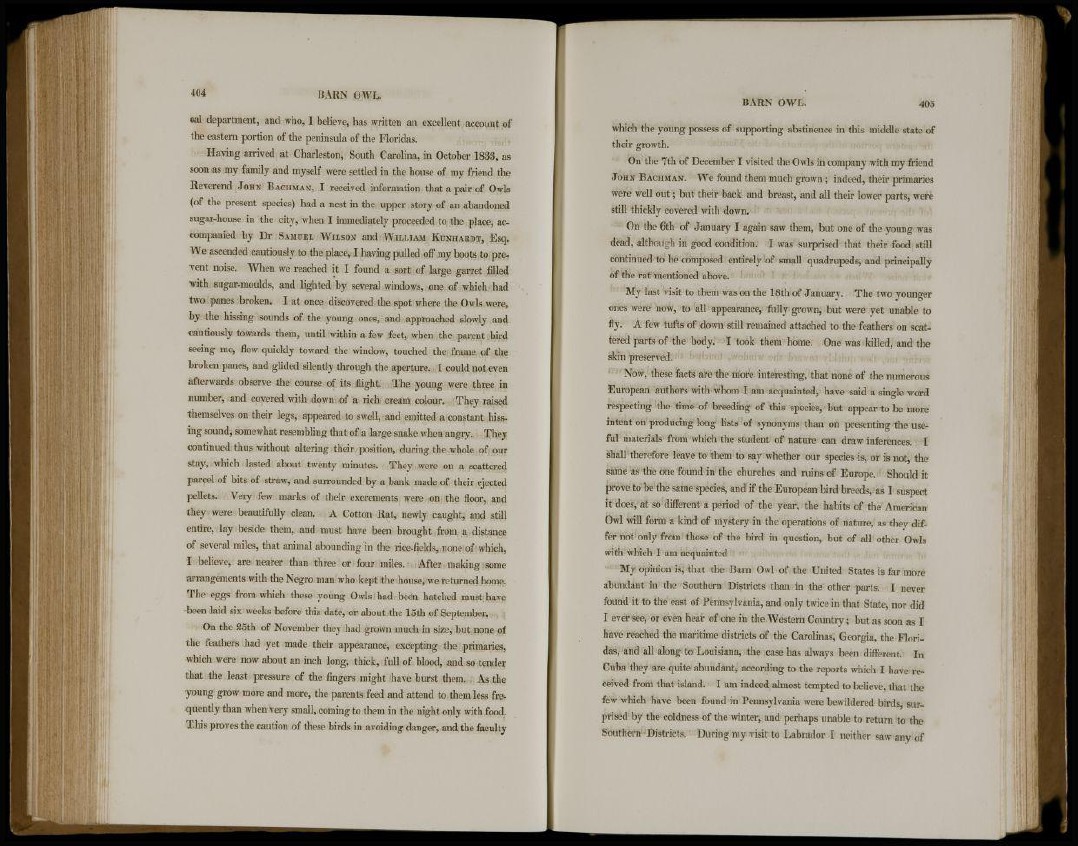
404 B A R N OWL.
©al department, and who, I believe, has written an excellent account of
the eastern portion of the peninsula of the Floridas.
Having arrived at Charleston, South Carolina, in October 1833, as
soon as my family and myself were settled in the house of my friend the
Reverend JOHN BACHMAN, I received information that a pair of Owls
(of the present species) had a nest in the upper story of an abandoned
sugar-house in the city, when I immediately proceeded to the place, accompanied
by Dr SAMUEL WILSON and W I L L I AM KDNHARDT, Esq.
We ascended cautiously to the place, I having pulled off my boots to prevent
noise. When we reached it I found a sort of large garret filled
with sugar-moulds, and lighted by several windows, one of which had
two panes broken. I at once discovered the spot where the Owls were,
by the hissing sounds of the young ones, and approached slowly and
cautiously towards them, until within a few feet, when the parent bird
seeing me, flew quickly toward the window, touched the frame of the
broken panes, and glided silently through the aperture. I could not even
afterwards observe the course of its flight. The young were three in
number, and covered with down of a rich cream colour. They raised
themselves on their legs, appeared to swell, and emitted a constant hissing
sound, somewhat resembling that of a large snake when angry. They
continued thus without altering their position, during the whole of our
stay, which lasted about twenty minutes. They were on a scattered
parcel of bits of straw, and surrounded by a bank made of their ejected
pellets. Very few marks of their excrements were on the floor, and
they were beautifully clean. A Cotton Rat, newly caught, and still
entire, lay beside them, and must have been brought from a distance
of several miles, that animal abounding in the rice-fields, none of which,
I believe, are nearer than three or four miles. After making some
arrangements with the Negro man who kept the house, we returned home.
The eggs from which these young Owls had been hatched must have
been laid six weeks before this date, or about the 15th of September.
On the 25th of November they had grown much in size, but none of
the feathers had yet made their appearance, excepting the primaries,
which were now about an inch long, thick, full of blood, and so tender
that the least pressure of the fingers might have burst them. As the
young grow more and more, the parents feed and attend to them less frequently
than when very small, coming to them in the night only with food.
This proves the caution of these birds in avoiding danger, and the faculty
B A R N OWL. 405
which the young possess of supporting abstinence in this middle state of
their growth.
On the 7th of December I visited the Owls in company with my friend
JOHN BACHMAN. We found them much grown ; indeed, their primaries
were well out; but their back and breast, and all their lower parts, were
still thickly covered with down.
On the 6th of January I again saw them, but one of the young was
dead, although in good condition. I was surprised that their food still
continued to be composed entirely of small quadrupeds, and principally
of the rat mentioned above.
My last visit to them was on the 18th of January. The two younger
ones were now, to all appearance, fully grown, but were yet unable to
fly. A few tufts of down still remained attached to the feathers on scattered
parts of the body. I took them home. One was killed, and the
skin preserved.
Now, these facts are the more interesting, that none of the numerous
European authors with whom I am acquainted, have said a single word
respecting the time of breeding of this species, but appear to be more
intent on producing long lists of synonyms than on presenting the useful
materials from which the student of nature can draw inferences. I
shall therefore leave to them to say whether our species is, or is not, the
same as the one found in the churches and ruins of Europe. Should it
prove to be the same species, and if the European bird breeds, as I suspect
it does, at so different a period of the year, the habits of the American
Owl will form a kind of mystery in the operations of nature, as they differ
not only from those of the bird in question, but of all other Owls
with which I am acquainted
My opinion is, that the Barn Owl of the United States is far more
abundant in the Southern Districts than in the other parts. I never
found it to the east of Pennsylvania, and only twice in that State, nor did
I ever see, or even hear of one in the Western Country ; but as soon as I
have reached the maritime districts of the Carolinas, Georgia, the Floridas,
and all along to Louisiana, the case has always been different. In
Cuba they are quite abundant, according to the reports which I have received
from that island. I am indeed almost tempted to believe, that the
few which have been found in Pennsylvania were bewildered birds, surprised
by the coldness of the winter, and perhaps unable to return to the
Southern Districts. During my visit to Labrador I neither saw any of